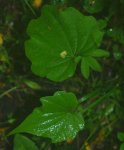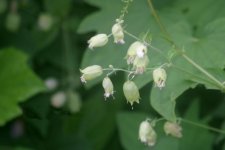Dioscorea nippon - dioscorea nipponica m.
Family Dioscoree - Dioscoreaceae
Botanical characteristics. Perennial grassy vine up to 5 m in height. Rhizome horizontally, up to 2 m long with cord-like stiff roots. The stems are bare, up to 4 m long and about 0.5 cm in diameter. Leaves are alternate, petiolate, with arcuate venation, shortly pubescent, broadly ovate in outline, with a large elongated, pointed median lobe. The lower leaves are semilobate, the middle leaves are trilobate, the upper leaves almost without blades. Flowers are small, with a simple deep-separate yellowish-green perianth. Staminate flowers on short pedicels in the semi-zoonotic; Pestle flowers with a lower ovary and a short column are collected in simple brushes. The fruit is an almost sessile three-cavity wide-elliptical capsule. Seeds are flat with a long webbed wing. Blossoms in July - August, fructifies in August - September.
Spread. It grows on forest edges, in bushes, on felling areas.
Used parts of the plant. Medicinal raw materials are roots and rhizomes, less often the above-ground part of the plant. Collect the roots and rhizomes in spring and autumn, wash and dry in dryers. Leaves and flowers are collected during flowering and dried on open air.
Chemical composition. Roots and rhizomes of Nippon Dioscorea contain flavonoids, carbohydrates, steroid saponins: dioscin, which decomposes into diosgenin, rhamnose and glucose. Diosgenin is a source for the synthesis of cortisone and other corticosteroids in the body. The maximum content of saponins in the plant at the end of vegetation. In this regard, it is better to collect rhizomes in autumn. Seeds contain fatty oil. The above-ground part, leaves and flowers contain vitamins and a small number of compounds that are found in the rhizomes.
Application. In the experiment the saponins of Nippon dioscorea are low in toxicity, but have an irritating effect on the mucous membranes. They are able to form insoluble complex compounds with cholesterol in the intestine; Intensify the effect of hypnotics and, as a rule, restore the rhythms of sleep; Reduce arterial pressure, dilate the peripheral system of blood vessels, increase the amplitude of heartbeats, deepen breathing, destroy the protein-lipoid complex as the basis for the development of atherosclerotic changes, which allows the use of dioscorea drugs in atherosclerosis. Preparations "Polisponin" and "Diosponin", obtained from different types of dioscorea, are used for general, cerebral and coronary atherosclerosis in the initial and expressed stages of the disease, for the treatment of liver and gallbladder diseases, hypertension. Tincture dioscorea is effective in exacerbating chronic gastritis. In this case, the secretory function of the stomach is markedly increased.
Preparation
- To prepare the broth, take 20 g of roots, grind, pour 200 ml of boiling water, insist on a boiling water bath for 30 minutes, cool 10 minutes, filter, bring to the desired volume. Take a decoction of 2 tbsp. Tablespoons 3-4 times a day after meals. Drink followed by milk or kissel.
- For infusion of 20 g of leaves and flowers, pour 200 ml of boiling water, insist on a boiling water bath for 15 minutes, filter after cooling (10-15 min), bring to the desired volume. Take 2 tbsp. Spoon 3-4 times a day after meals.
- A stick from the roots is prepared on 70% alcohol at a rate of 1: 5, insist 10 days and take 30-40 drops per reception 3 times daily before meals.
The finished preparations are applied according to the instructions attached to the preparations and to the doctor's prescription.





Comments
When commenting on, remember that the content and tone of your message can hurt the feelings of real people, show respect and tolerance to your interlocutors even if you do not share their opinion, your behavior in the conditions of freedom of expression and anonymity provided by the Internet, changes Not only virtual, but also the real world. All comments are hidden from the index, spam is controlled.